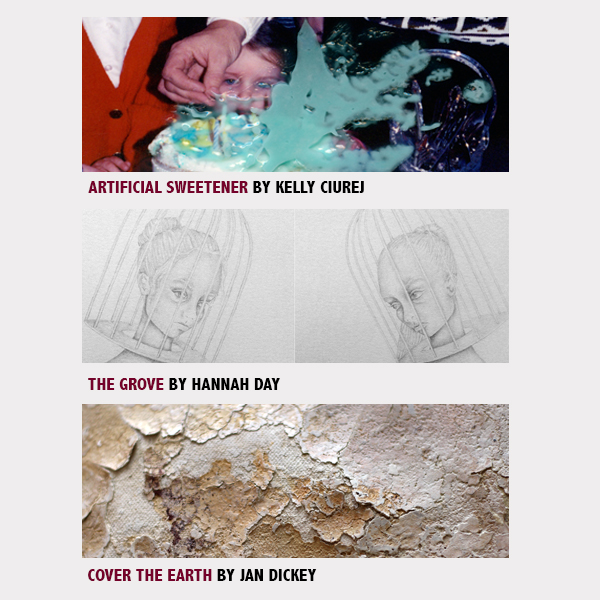![]() EXHIBITION
EXHIBITION
2017 MFA THESIS EXHIBITIONS
March 5 – April 7, 2017
The Art Gallery at the University of Hawai‘i at Mānoa
SPECIAL EVENTS:
All events are free and open to the public.
Sunday, March 5, 2017
2:00 – 3:00 p.m. Gallery walk-throughs
2:00 p.m. Jan Dickey
2:20 p.m. Hannah Day
2:40 p.m. Kelly Ciurej
3:00 – 5:00 p.m. Opening reception + music by The Drowning Dreamers Band
Friday, March 17, 2017
1:00 p.m. Hannah Day, Thesis defense
Friday, March 24, 2017
1:00 p.m. Kelly Ciurej, Thesis defense
Friday, April 7, 2017
1:00 p.m. Jan Dickey, Thesis defense
The graduate program at the Department of Art + Art History, University of Hawai‘i at Mānoa is a comprehensive and diverse center for the graduate study of the visual arts and Asian and Pacific art history. The exciting thesis exhibitions are part of a demanding course of study, production, and review. MFA candidates concurrently present new and engaging works that demonstrate each artist’s caliber of ideas, skills, awareness of the global context within which art is created and circulated, and critically engaged artistic practice.
The artists, the titles of their exhibitions, and their areas of specialization are:
Kelly Ciurej, Artificial Sweetener, (photography)
Hannah Day, The Grove, (printmaking)
Jan Dickey, cover the earth, (painting)
EXHIBITION SUMMARIES + ARTIST STATEMENTS:
Kelly Ciurej presents Artificial Sweetener, an installation of digital prints
Artificial Sweetener is an exhibition that explores psychological “stickiness.” With this project Ciurej explores the misrepresentation of images as truth. The installation consists of approximately fifteen photographs at larger than life scale, in a combination of found family photographs, recipes, and staged performative studio photographs using sticky material such as sugars, food dyes, candies, pastries, processed foods, etc.
Artificial Sweetener is both an exhibition and an exploration of psychological “stickiness.” In these photographs, I exploit food materials that are largely glutinous—candies, pastries, and sugary treats—to study certain spaces of the mind that are internalized from familial experiences. The substances I manipulate are often heavy, sweet, sugar-based confections, widely used in processed foods as well as within the household setting for baked goods. They express both excess and absence, as these particular substances are the epitome of “junk foods,” high in additives and artificial sweeteners, but provide no value to the human body, often even causing it palpable harm. This material serves as a stand-in for an inescapable, smothering stickiness of the emotional spaces I am investigating through photography. The Artificial Sweetener installation is a way to visually explore and re-contextualize the shifting systems that are present within a nuclear family—to question an assumed knowledge of the past and the invented realities we often create for ourselves and for others.
Hannah Day presents The Grove, an installation of prints and drawings
These works in graphite and intaglio explore the uncertainty and perceived futility that consumes the life of the figure, a character explored through undefined narratives constructed primarily with repetitious imagery. A woman wearing a cage over her head like a helmet wanders the world of her subconscious, seemingly alone. At moments she is joined by a second figure, at others, she is isolated in a dense thicket of trees. A series of graphite drawings appear ghostly on the page, smooth and seamless impressions of unassuming portraits. In contrast, installations assembled of cut elements from line etchings are pieced together with the texture of a puzzle being put together with the wrong pieces.
Picturing one’s mental space as a literal terrain to be traversed and explored, The Grove puts on display the mental wanderings of one individual. A female figure is shown traipsing about the locales that compose her inner landscape, a space made up of densely wooded areas and pockets of stark nothingness. In her travels she finds things hidden amongst the trees that continually dissolve her trust in the line between real and imagined. Subject matter is rendered with a minimal value range, highlighting the work’s consideration of the ephemerality of her psychology and the instability of her understanding of her self and all that exists around her.
Jan Dickey presents cover the earth, an installation of paintings
The exhibition cover the earth focuses on two forms of painting: covering wall panels and painting on canvas. This installation of panels and canvases can be considered in sections or as one single painting. In either case, they are fragments of the great Painthing that covers the earth.
Paint never forms an everlasting impregnable lamination. People have gone to great lengths to design paints that will permanently bind earthly things into artificial spaces and aesthetic objects. Yet painted surfaces still eventually crack, flake, and discolor. The earth gets back in.
To better explore paint delamination and discoloration, I use pre-industrial painting materials like milk, eggs, animal glue, roots, and dirt. These materials take me deeper into the history of painting and closer to an understanding of paints as earthly substances.
The exhibition cover the earth emerges out of a love for watching entropy tug at the framed-off things people presume to be stable spaces and objects. As a painting project occurring in a gallery space, cover the earth specifically investigates the frame—the artificial edges—of personal-sized canvases and standard wall panels. With this exhibition, I have tried to make a place for those categories to erode into one another, to fade into whiteness, and slowly crack apart.
Gallery hours + admission:
Mon. – Fri. 10:00 a.m. – 4:00 p.m.
Sun. 12:00 – 4:00 p.m.
Closed Saturdays, Prince Kūhiō Day, Mar. 27.
By appointment: Spring Break, Mar. 28 – 31.
Free admission. Donations are appreciated.
Parking fees may apply.
SPONSORS: University of Hawai‘i at Mānoa’s Department of Art + Art History and College of Arts + Humanities; and supported by Waikiki Parc Hotel – Hospitality Sponsor for the Arts at UH Mānoa; Student Activity and Program Fee Board, UHM; and anonymous donors.

